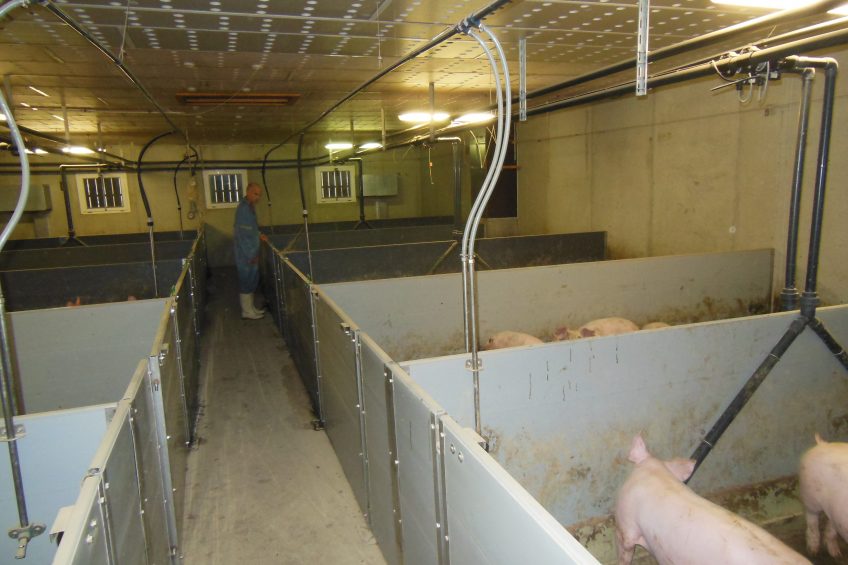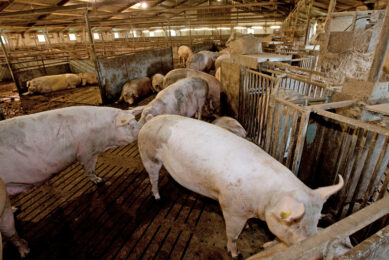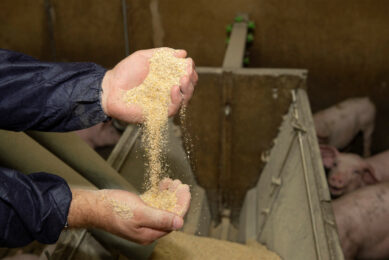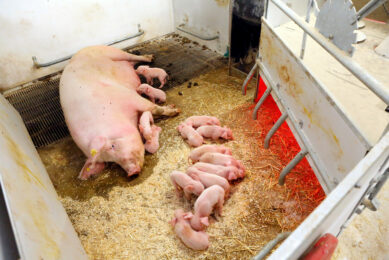Floors, ceilings, heights – all are tested in Britanny

The Chambers of Agriculture in Brittany, France, are able to carry out a host of studies at the research farms of Crécom and Guernévez. Various topics come along: Feeding, welfare, health, environment, and a lot of innovative building management.
For its pig research, Britanny’s Chambers of Agriculture relies on a team of 30 people spread out on two locations. One can be found in Crécom and the other in Guernévez. Both are introduced in this article.
Crécom research farm
The Crécom research farm is situated in the heart of Brittany, France, in the departement of Côte d’Armor, 134 km west of Rennes. The station, located near the village of Saint Nicolas du Pélem, is surrounded by a nice nature. Bertrand Le Bris has been the centre’s director since 2011. He is also the Guernévez station’s director.
Biosafety is one of the first visible characteristics of Crecom station. The visitor has to take a shower and to wear new clothes before entering and he also needs to change external working clothes plus shoes before entering each building. Le Bris explains: “Visitors should not have visited other pig farms 48 hours prior to the visit. Anything entering the station is desinfected.”
Two units
The Crécom research station consists of two units of 57 sows managed parallel. One group is kept on a slatted floor and the other one on a straw bedding. The station is managed by an all-in all-out system in three groups of 19 sows. Weaning occurs at 28 days. The site produces 2,600 market pigs per year and is managed by a team of six employees. Four of them are working on the pigs and two manage the surroundings – this includes 125 ha used for crops, cattle and manure spreading.
Entirely rebuilt in 2005, Crécom is specialised in research on feeding, breeding management and on a general comparison of the two systems on slatted floors and on straw.

Slatted floor unit
The ‘slatted floor’ unit keeps gestating sows in three rooms of 24 places each: Two rooms with free access stalls, with a possibility to block pregnant sows until four weeks after insemination, plus one room equiped with Electronic Sow Feeding station. Le Bris says, “Each room can distribute two kinds of feed. There is no slurry stored under the animals thanks to a manure scraper at the bottom of the pit.”
The slatted floor unit also has two farrowing houses for ten sows each. Le Bris explains, “In 2014 we will start trials focusing on factors that may shed a light on mortality in neonatal piglets.” The trials will be made in cooperation with the French National Institute of Agricultural Research (INRA) and fall within the framework of the European ProHealth project. This project will develop an understanding of the multifactorial dimensions of animal pathologies linked to the intensification of production. The project will develop, evaluate and disseminate effective control strategies to reduce their impact. Its coordinated by the University of Newcastle-upon-Tyne, UK. Read more about this research on page 21.
The grower facilities consist of two rooms of ten pens for 11 piglets each. There is no more mixing of piglets after weaning and each pen has a variable area from 0.35 to 0.55 m2/piglet. Each room can be managed in two separated half-rooms both for feed and slurry.
Lastly, the finishing section on slatted floors is composed of six rooms of which three for dry feed and three for liquid feed. A scraper continuously disposes the slurry outside the building. On the six rooms, four are composed of eight pens for 11 pigs each; two experimental rooms are equipped with 72 pigs per room. In two rows of six pens for six pigs each, precise analysis is made what exactly happens during feeding. In these rooms, all distributed feed as well as leftovers are weighed.

Straw-based unit
The unit managed on straw has two grower rooms, each one having two pens of 55 piglets.
Piglets arrive at the age of 28 days and stay around 31 days before moving to six finishing rooms (having each two pens of 42 to 44 pigs) where they will stay until the weight of 115 kg. It is possible to have one feed per pen and the specifications of the finishing pens are various: On a total of six pens, three are also equiped for dry feed and three for liquid feeding.
The finishing rooms on straw also have a variable ceiling level, with two rooms having a relatively small volume (i.e. a low ceiling) and four rooms having a high volume. Le Bris states this is to reproduce on-farm reality. The room is also equipped with an Innova photoacoustic field gas-monitor. This Danish innovation is able to analyse air samples of air from the different rooms and to measure ammonia, nitrous oxide (N2O), carbon dioxide (CO2), methane (CH4), and steam. With regard to these air control trials, a group consisting of 12 engineers attached to the Britanny Chambers of Agriculture is continuously exchanging information with colleagues from institutes throughout France.
Technical results
In 2011, technical results of this farm provided a mixed picture. With regard to sows on straw, these were above the based average in Britanny, but the sow results on the slatted floor scored worse than the regional average. The difference is expressed in a better prolificacy (13.6 liveborn piglets per litter), a lower mortality rate amongst liveborn piglets (9.7) and a better conception rate of the sows at first mating (94.8%) for the unit on straw litter.
Performances in the grow-finish faciliy are excellent in both units, with pigs reaching a slaughterweight of 115 kg almost three weeks quicker than the regional average (157 days for the finishers on slatted floors instead of 183 days). Performances for weaner pigs are similar when kept on slatted floors or on straw, but losses are higher for weaners on a slatted floor (2.6%) in comparison to their peers on straw (0.4%).

Research topics
Le Bris explains that all partners in the pig production chain take part in deciding which research will be conducted. Some recent research topics include how to finish non-castrated male pigs and how to reduce protein content in these diets. Le Bris says, “We all agreed to stop male castration by 2018 in the European Union, on the condition of finding a odour detection method in the slaughterhouses.”
Farrowing house of the future
Created at the beginning of the 1970s, the research farm of Guernévez, in the departement Finitère, is specialised in research on livestock buildings, energy, animal welfare and the environment. This station, with 149 productive sows (180 present) in seven groups, and with 4,100 slaughter pigs produced per year, has a team of eight employees. It also tests new equipments and it counts 35 different types of buildings for all physiological stages on a total of 3 ha of experimental area.
Frédéric Kergourlay, in charge of the Pig and Poultry Pole of the Chamber of Agriculture of Quimper, one of the station’s actual key projects is to build a farrowing house of the future, as from mid-January 2014. The aim of this farrowing house of 24 places (two rooms of 12 places) is to bring innovations both on equipment and on building.
Kergourlay explains the project’s two priorities: Ergonomy and energy saving. One of the rooms will be without piglet nests with a temperature of 24°C, and the other one will have nests at a a temperature of 18-20°C only. In order to limit energy consumption, representing 22% of the total energy consumption, of a pig unit, the project has several aims:
• To reduce energy consumption creating a compact building with reinforced insulation and piglet nests;
• To valorise free energy with the optimisation of natural lighting with glass surfaces, skylights (three per half room) and the installation of an air exchanger;
• To produce a renewable energy by installing solar panels to produce warm water linked to a heat pump.
Four different models of sow stalls will be tested (from I-Tek, Gavelpor, Nooyen and Big Dutchman respectively) while a system of floor-heating plates will be installed.
With regard to ergonomy, a lowered central corridor (lane) of adaptable height should ease the care for animals. A juxtaposed building will be also partly renovated to create new cages where sows will be able to walk in freedom (this project is done in cooperation with INRA).

Visitors
The facility of Guernévez is visited well every year: Between 1,000-1,500 people visit Guernévez farm every year to discover the latest trends and equipment in the pig business. In 2006, a centre for energy resources in agriculture was created in this farm, this allows visitors to see to visit an exhibition of a new generation of insulation, including wool, hemp or wood fibres.
In addition, the valorisation of manure is one of the main topics of Guernévez farm. Several trials are conducted to process manure into various organic fertilisers.
Le Bris says, “We are actually promoting V-shaped scrapers to separate solid to liquid phases of manure.” The goal of this equipment is to concentrate 90% of the phosphorus, 55% of the nitrogen and 45% of the potassium in the solid part. He adds, “This scraper also improves the sanitary status of the pig farm with better technical results.”
He is open to any test of equipment coming from abroad, stating: “We are able to assess new equipments with precision and our work is then completed by on farm testings.”
– What is the maximum feed supply during finishing?
Four levels of daily feed supply have been compared at the end of the finishing period (2.35 kg, 2.5 kg, 2.65 kg and ad lib) on two consecutive groups of 96 pigs each. The diet limited at 2.5 kg got the best margin on feed cost.
– Ammonia and greenhouse gas emissions of straw-based finishers
Compared to a bedding of sawdust, straw bedding results in fewer emissions of nitrous oxide (N2O) or greenhouse gas, but more ammonia (NH3). In dry feeding, there are more emissions of nitrous oxide than when fed liquid feed.
– Leg problems with group housed sows (2010-2011):
To solve leg problems with sows on slatted floors in groups with ESF, both Crécom and Guernévez modified their laying areas which significatively improved the situation.
– Effect of dietary crude protein reduction on finisher performance
The reduction of dietary crude protein by 1 point allowed to reduce the nitrogen intake by 9% and the nitrogen output by 15%. At the time of the visit, the feeding cost of the low crude protein diet was 3% lower than the control diet.











